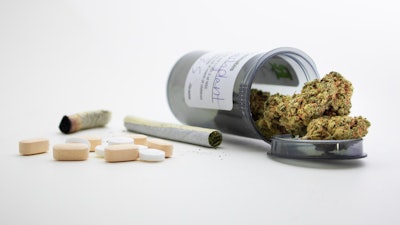
A new study from New York State and CUNY researchers suggests that receiving medical cannabis for thirty days or more may help patients on long-term opioid treatment to lower their dose over time.
The study, published today in the Journal of the American Medical Association (JAMA) Network Open, found an association between receiving medical cannabis for chronic pain for a longer duration and a reduction in prescription opioid dosages among patients on long-term opioid therapy. Patients who were on higher baseline dosages of prescription opioids when they started receiving medical cannabis experienced larger reductions in opioid dosages.
These findings leverage existing population-level data to contribute robust evidence for clinicians regarding the potential clinical benefits of medical cannabis in reducing the opioid burden for long-term opioid therapy patients, and possibly reducing their risk for use of illicit substances and overdose. The findings could further inform policies in other jurisdictions, where medical cannabis is not yet legalized.
Researchers from the CUNY Graduate School of Public Health and Health Policy (CUNY SPH), the New York State Department of Health, and the New York State Office of Cannabis Management used a combination of two large state databases to analyze data from eight thousand adult New Yorkers during 2017-2019. They evaluated prescription opioid dosages of participants during the 12 months prior to receipt of medical cannabis and up to eight months later.
For each month of the study, the researchers compared the average daily morphine milligram equivalent (MME) for those who received medical cannabis for more than 30 days vs. those who received 30 days or less.
"This study found meaningful reductions among patients receiving medical cannabis for longer duration,” said lead author Dr. Trang Nguyen of the Department of Health. “Patients’ daily opioid dosages were reduced by 47%-51% of the baseline dosages after eight months. In contrast, patients receiving medical cannabis for a shorter duration reduced their initial dosages by just 4%-14%."
The following results were observed eight months after patients started receiving medical cannabis:
- Among patients with the lowest MME (less than 50 MME), the average daily MME at the end of the follow-up period for patients with longer medical cannabis duration was reduced 48% from baseline. In contrast, there was a 4% reduction from baseline for patients with shorter medical cannabis duration. This resulted in a total MME net reduction of -14.53 (range, -17.45 to -11.61) over eight months for patients receiving medical cannabis for a longer duration.
- Among patients with a baseline MME of 50 to 89, the average daily MME at the end of the follow-up period for patients with longer medical cannabis duration showed a 47% reduction from baseline versus 9% reduction for patients with a shorter medical cannabis duration. This resulted in a total MME net reduction of -29.49 (range, -35.94 to -23.04) over eight months for patients receiving medical cannabis for a longer duration.
- For adults with a baseline MME at 90 or greater, by the end of the follow-up period, the daily MME for patients with longer medical cannabis duration, there was a 51% reduction from baseline versus 14% reduction for patients with shorter medical cannabis duration. This resulted in the largest MME net reduction of -69.81 (range, -87.09 to -52.53) over eight months for patients receiving longer medical cannabis duration.
“These findings have important implications for clinicians and policy makers,” said co-author Dr. Danielle Greene of CUNY SPH. “They provide evidence for another tool to be used in response to the opioid epidemic. Changes in attitudes and policies toward opioid prescribing over the past decade have left some patients dependent on long-term high dosage prescriptions but fewer providers willing to write these prescriptions. Previous research has shown that abrupt disruption in opioid prescriptions among patients on high dosages and long-term opioid therapy can lead to patients’ use of illicit drugs, overdose, and self-harm. Our study suggests a more humane option for achieving lower prescription dosages and potentially reducing those risks. Equitable implementation of these findings will require addressing disparities in both access to medical cannabis due to high cost and the high rate of patients receiving long-term opioid therapy in Medicaid and other programs.”
“Since the inception of the Medical Cannabis Program in New York State, we’ve heard anecdotal evidence from patients, caregivers and health care providers suggesting that medical cannabis can reduce the amount of opioids patients take to manage pain – and now we have the study demonstrating a statistically significant reduction for those patients who were on medical cannabis for a longer duration,” said co-author Nicole Quackenbush of the NYS Office of Cannabis Management. “Research is critical to further our knowledge of the potential risks and benefits of cannabis and the OCM will be continuing efforts to promote cannabis knowledge and research in New York State.”






















